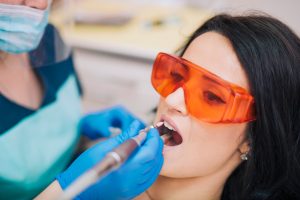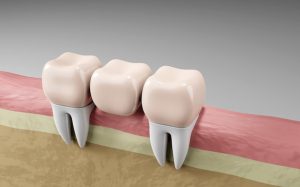Table of Contents
TL;DR
- Periodontal disease affects the gums and bones around the teeth.
- There are different stages with unique signs and symptoms:
- Gingivitis causes red, swollen gums that bleed but can be fully reversed.
- Mild periodontitis forms pockets, causes sensitivity, and early bone damage, manageable with deep cleaning.
- Moderate periodontitis worsens bone loss and loosens teeth.
- Advanced periodontitis leads to severe gum/bone damage, loose teeth, pain, and chewing difficulty. It is often irreversible.
- Risk factors include poor hygiene, smoking, family history, diet, hormones, stress, and health conditions.
Understanding the Stages of Periodontal Disease
Sometimes gums can feel sore or bleed a little while brushing or flossing. It may seem harmless, but it can be an early sign of something more serious: periodontal disease. This common condition affects not only the gums but also the tissues that support your teeth. If left untreated, it can gradually worsen, potentially leading to complications such as tooth loss.
This is why understanding the stages of periodontal disease is so important. By knowing how it develops and what to look out for, you can recognize the warning signs early and seek the right care. Let’s take a closer look.
What is Periodontal Disease?
Periodontal disease, also known as gum disease, is an infection or inflammation of the gums and tissues that hold your teeth in place. It starts when plaque (a sticky biofilm of bacteria) builds up on your teeth, triggering gum inflammation and an immune response. This causes the gums to become red, swollen, and sometimes bleed.
If not treated on time, this disease can cause serious problems like loose teeth or even permanent tooth loss. This, in turn, can make it hard to speak or eat properly, lowering your self-confidence. In some severe cases, it can also increase your chances of developing other health issues like heart problems or diabetes.
In the United States, periodontal disease is very common. Almost half of all adults over the age of 30 are affected by some form of gum disease. It is even more common among older people, with over 60% of them (over 65 years of age) suffering from it.
Recognizing the Stages of Periodontal Disease
Periodontal disease progresses in a series of stages. At Anoka Dental, our specialists note that each stage has distinct signs and requires specific treatments.
The stages of periodontal disease include:
Gingivitis
This is the earliest stage of periodontal disease.
Symptoms
- The gums appear red and swollen
- Gums might bleed easily during brushing and flossing
- Bad breath may be present
Changes in the mouth
- Plaque buildup near the gum line
- Gums become inflamed, but the bone remains healthy
Treatability
- This is an early stage of periodontal disease and is fully reversible
- Good oral hygiene, regular brushing, flossing, and dental cleaning help solve gum issues
Mild Periodontitis
If the gingivitis stage is ignored, the infection can spread deeper under the gums. Some bone around the teeth may start to break down.
Symptoms
- Gums may bleed frequently and feel more swollen
- The gums can recede, producing tiny spaces, called pockets, between the teeth
- There is mild bad breath
- Teeth may feel sensitive
Changes in the mouth
- Bacteria and plaque move deeper under the gums
- Early bone damage surrounding the teeth begins
Treatability
- This stage may not be fully reversible, but it is manageable
- Dental cleaning might be necessary to remove plaque and bacteria from below the gum line
- Regular dental checkups can help stop further damage

Moderate Periodontitis
In this stage of periodontal disease, the problems become more noticeable. The bone loss around the teeth worsens.
Symptoms
- Gums pull away from the teeth, and the pockets deepen
- The teeth may appear longer due to the pulling away of the gum tissue
- The teeth might feel loose or uncomfortable when chewing
- Bad breath may worsen
Changes in the mouth
- At this stage of periodontal disease, there is more bone loss around the teeth
- You might have more chances of developing dental infections like abscesses (pus-filled sacs)
Treatability
- Bone loss and tissue damage cannot be reversed, making the treatment hard
- Treatments include deep cleaning, medicines like antibiotics, or even minor surgery
- Regular dental checkups and oral care are very important
Advanced Periodontitis
In this stage, there are severe changes to your gum tissues and the bone surrounding the teeth.
Symptoms
- Severe gum swelling, redness, and pain
- Pus may form around the teeth
- Teeth become loose, shift position, or may fall out
- Chewing is painful, and you may find it difficult to eat
- Bad breath is strong
Changes in the mouth
- There is severe bone and gum tissue loss
- Large gum pockets are filled with bacteria
Treatability
- This stage is usually irreversible, and the treatment focuses on controlling infection, preserving remaining teeth, and restoring function.
- You may require surgery to rebuild gum and bone tissue
- Regular dental checkups and oral care are necessary to control damage
Risk Factors for Periodontal Disease
Periodontal disease does not just occur overnight. It often builds up over time because of certain habits and health problems. Knowing these factors helps you to understand how to protect your gums and teeth.
- Poor Oral Hygiene: If brushing and flossing are neglected, bacteria stay on the teeth, forming plaque that harms the gums.
- Smoking: Smoking is another major lifestyle habit that weakens the mouth’s ability to heal and makes gum infections common.
- Family History: If parents or your relatives in the family had periodontal disease, your chances of getting it are higher.
- Unhealthy Diet: A diet low in essential nutrients, especially vitamin C, weakens the body’s ability to maintain healthy gums. Eating too much sugary, starchy food can also increase the risk.
- Hormonal Changes: Puberty, pregnancy, and menopause cause hormonal changes, which can lead to sensitive, bleeding gums.
- Stress: High stress levels can weaken your body’s immune system and make it harder to fight infections.
- Medical Problems: Diabetes and other illnesses that affect immunity increase the risk and severity of gum disease.

Takeaway
Periodontal disease is a slow-developing dental problem that can harm your gums and teeth. It begins with gingivitis and may progress to advanced stages if ignored. Understanding each stage of periodontal disease helps in spotting early warning signs and taking prompt action. With daily brushing, flossing, healthy eating, and regular dental checkups, most gum problems can be managed.
At Anoka Dental, the expert dentists carefully check for early signs of periodontal disease and provide the right treatments to protect your smile. With gentle and thorough dental care at Anoka, MN, they guide you towards healthier gums and stronger teeth.
Contact us: (763) 421-4002
Visit: 12 Bridge Square, #106, Anoka, MN 55303
FAQs
What are the early signs of periodontal disease?
Early signs of periodontal disease may include red, swollen, and painful gums. You may also notice bleeding while brushing and flossing, followed by bad breath.
Can gum disease be reversed if detected early?
Yes, gum disease can often be reversed if it is detected at an early stage. This is possible through proper brushing, flossing, eating healthy, and regular dental checkups.
How can I recognize the symptoms of gingivitis?
Signs of gingivitis include swollen gums and bleeding when brushing or flossing.
Are certain people more prone to developing gum disease?
Yes, some people are more likely to get gum disease. Poor brushing, sugary foods, family history, smoking, and some health problems can increase your chance of developing gum disease.
What lifestyle changes help prevent periodontal disease?
To prevent periodontal disease, you must brush and floss your teeth daily, eat healthy foods, reduce sugary foods, avoid smoking, and visit your dentist regularly.




